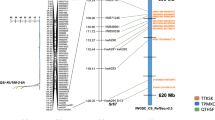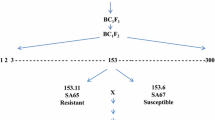Abstract
Key message
A new and dominant R gene Stb19 is identified from a soft wheat cultivar ‘Lorikeet’ and was mapped on the distal region of chromosome 1DS. Two tightly linked KASP markers were also discovered and validated for molecular-assisted breeding programs.
Abstract
A new R gene, designated as Stb19, provides resistance to Zymoseptoria tritici in wheat. This new dominant gene resides on the short arm of chromosome 1D, exhibiting complete resistance to three Z. tritici isolates, WAI332, WAI251, and WAI161, at the seedling stage. A genetic linkage map, based on an F2:3 population of ‘Lorikeet’ and ‘Summit,’ found the Stb19 gene at a 9.3 cM region on 1DS, closely linked with two Kompetitive Allele-Specific PCR markers, snp_4909967 and snp_1218021. Further, the two markers were tested and validated in another F2:3 population and 266 different wheat accessions, which gave over 95% accuracy of resistance/susceptibility prediction. Combined with the physical location of the identified SNPs and the previous evidence of gene order on chromosome 1DS (centromere–Sr45–Sr33–Lr21–telomere), Stb19 is proposed to be located between Sr33 and Lr21. Thus, the newly discovered Stb19 along with the KASP markers represents an increase in genetic resources available for wheat breeding resistance to Z. tritici.




Similar content being viewed by others
References
Akbari M, Wenzl P, Caig V, Carling J, Xia L, Yang S, Uszynski G, Mohler V, Lehmensiek A, Kuchel H (2006) Diversity arrays technology (DArT) for high-throughput profiling of the hexaploid wheat genome. Theor Appl Genet 113:1409–1420
Ballantyne B (1985) Resistance to speckled leaf blotch of wheat in southern New South Wales. ARS US Department of Agriculture, Agricultural Research Service
Blake JJ, Gosling P, Fraaije BA, Burnett FJ, Knight SM, Kildea S, Paveley ND (2018) Changes in field dose–response curves for demethylation inhibitor (DMI) and quinone outside inhibitor (QoI) fungicides against Zymoseptoria tritici, related to laboratory sensitivity phenotyping and genotyping assays. Pest Manag Sci 74:302–313
Broman KW, Sen S (2009) A guide to QTL mapping with R/qtl. Springer, Berlin
Brown JK, Chartrain L, Lasserre-Zuber P, Saintenac C (2015) Genetics of resistance to Zymoseptoria tritici and applications to wheat breeding. Fungal Genet Biol 79:33–41
Chartrain L, Berry ST, Brown JKM (2005) Resistance of wheat line Kavkaz-K4500 L.6.A.4 to Septoria tritici blotch controlled by isolate-specific resistance genes. Phytopathology 95:664–671
Cools HJ, Fraaije BA (2013) Update on mechanisms of azole resistance in Mycosphaerella graminicola and implications for future control. Pest Manag Sci 69:150–155
Dooley H, Shaw MW, Mehenni-Ciz J, Spink J, Kildea S (2016) Detection of Zymoseptoria tritici SDHI-insensitive field isolates carrying the SdhC-H152R and SdhD-R47 W substitutions. Pest Manag Sci 72:2203–2207
Eriksen L, Shaw MW, Østergård H (2001) A model of the effect of pseudothecia on genetic recombination and epidemic development in populations of Mycosphaerella graminicola. Phytopathology 91:240–248
Eyal Z (1987) The Septoria diseases of wheat: concepts and methods of disease management. CIMMYT
Fones H, Gurr S (2015) The impact of Septoria tritici Blotch disease on wheat: an EU perspective. Fungal Genet Biol 79:3–7
Hagerty CH, Graebner RC, Sackett KE, Mundt CC (2017) Variable competitive effects of fungicide resistance in field experiments with a plant pathogenic fungus. Ecol Appl 27:1305–1316
Huang L, Brooks SA, Li W, Fellers JP, Trick HN, Gill BS (2003) Map-based cloning of leaf rust resistance gene Lr21 from the large and polyploid genome of bread wheat. Genetics 164:655–664
Kassa MT, Haas S, Schliephake E, Lewis C, You FM, Pozniak CJ, Kramer I, Perovic D, Sharpe AG, Fobert PR, Koch M, Wise IL, Fenwick P, Berry S, Simmonds J, Hourcade D, Senellart P, Duchalais L, Robert O, Forster J, Thomas JB, Friedt W, Ordon F, Uauy C, McCartney CA (2016a) A saturated SNP linkage map for the orange wheat blossom midge resistance gene Sm1. Theor Appl Genet 129:1507–1517
Kassa MT, You FM, Fetch TG, Fobert P, Sharpe A, Pozniak CJ, Menzies JG, Jordan MC, Humphreys G, Zhu T, Luo MC, McCartney CA, Hiebert CW (2016b) Genetic mapping of SrCad and SNP marker development for marker-assisted selection of Ug99 stem rust resistance in wheat. Theor Appl Genet 129:1373–1382
Kema GHJ, Verstappen ECP, Todorova M, Waalwijk C (1996) Successful crosses and molecular tetrad and progeny analyses demonstrate heterothallism in Mycosphaerella graminicola. Curr Genet 30:251–258
Kirikyali N et al (2017) Azole and SDHI sensitivity status of Zymoseptoria tritici field populations sampled in France, Germany and the UK during 2015. In: Deising HB, Fraaije B, Mehl A, Oerke EC, Sierotzki H, Stammler G (eds) Modern fungicides and antifungal compounds, vol VIII. Deutsche Phytomedizinische Gesellschaft, Braunschweig, pp 153–158
Linde CC, Zhan J, McDonald BA (2002) Population structure of Mycosphaerella graminicola: from lesions to continents. Phytopathology 92:946–955
Mergoum M, Singh PK, Ali S, Elias EM, Anderson JA, Glover KD, Adhikari TB (2007) Reaction of elite wheat genotypes from the northern Great Plains of North America to Septoria diseases. Plant Dis 91:1310–1315
Milgate A (2014) Septoria tritici blotch has increased in importance in high-rainfall areas of the southern GRDC region and careful attention to fungicide strategies is required to minimise the chances of further resistance developing. Ground Cover™ Issues. GRDC, Australia
Mundt C, Hoffer M, Ahmed H, Coakley S, DiLeone J, Cowger C (1999) Population genetics and host resistance. In: Lucas JA, Bowyer P, Anderson HM (eds) Septoria on cereals: a study of pathosystems. CAB International, Wallingford, pp 115–130
Murray GM, Brennan JP (2009) Estimating disease losses to the Australian wheat industry. Australas Plant Path 38:558–570
Naz AA, Kunert A, Lind V, Pillen K, Léon J (2008) AB-QTL analysis in winter wheat: II. Genetic analysis of seedling and field resistance against leaf rust in a wheat advanced backcross population. Theor Appl Genet 116:1095–1104
Naz AA, Klaus M, Pillen K, Léon J, Miedaner T (2015) Genetic analysis and detection of new QTL alleles for Septoria tritici blotch resistance using two advanced backcross wheat populations. Plant Breeding 134:514–519
Periyannan S, Moore J, Ayliffe M, Bansal U, Wang X, Huang L, Deal K, Luo M, Kong X, Bariana H (2013) The gene Sr33, an ortholog of barley Mla genes, encodes resistance to wheat stem rust race Ug99. Science 341:786–788
Periyannan S, Bansal U, Bariana H, Deal K, Luo M-C, Dvorak J, Lagudah E (2014) Identification of a robust molecular marker for the detection of the stem rust resistance gene Sr45 in common wheat. Theor Appl Genet 127:947–955
Ponomarenko A, Goodwin SB, Kema GHJ (2011) Septoria tritici blotch (STB) of wheat. Plant Health Instructor
Ramirez-Gonzalez RH, Segovia V, Bird N, Fenwick P, Holdgate S, Berry S, Jack P, Caccamo M, Uauy C (2015) RNA-Seq bulked segregant analysis enables the identification of high-resolution genetic markers for breeding in hexaploid wheat. Plant Biotechnol J 13:613–624
Simón M, Ayala F, Cordo C, Röder M, Börner A (2004) Molecular mapping of quantitative trait loci determining resistance to septoria tritici blotch caused by Mycosphaerella graminicola in wheat. Euphytica 138:41–48
Singh S, Sidhu J, Huang N, Vikal Y, Li Z, Brar D, Dhaliwal H, Khush G (2001) Pyramiding three bacterial blight resistance genes (xa5, xa13 and Xa21) using marker-assisted selection into indica rice cultivar PR106. Theor Appl Genet 102:1011–1015
Somers DJ, Isaac P, Edwards K (2004) A high-density microsatellite consensus map for bread wheat (Triticum aestivum L.). Theor Appl Genet 109:1105–1114
Steuernagel B, Periyannan SK, Hernandez-Pinzon I, Witek K, Rouse MN, Yu G, Hatta A, Ayliffe M, Bariana H, Jones JD, Lagudah ES, Wulff BB (2016) Rapid cloning of disease-resistance genes in plants using mutagenesis and sequence capture. Nat Biotechnol 34:652–655
Sykes EM, Sackett KE, Severns PM, Mundt CC (2017) Sensitivity variation and cross-resistance of Zymoseptoria tritici to azole fungicides in North America. Eur J Plant Pathol 151:1–6
Taylor J, Butler D, Taylor MJ (2015) Package ‘ASMap’. Linkage map construction using the MSTmap Algorithm R Package. https://CRANR-project.org/package=ASMap
Torriani SFF, Brunner PC, McDonald BA, Sierotzki H (2009) QoI resistance emerged independently at least 4 times in European populations of Mycosphaerella graminicola. Pest Manag Sci 65:155–162
Torriani SF, Melichar JP, Mills C, Pain N, Sierotzki H, Courbot M (2015) Zymoseptoria tritici: a major threat to wheat production, integrated approaches to control. Fungal Genet Biol 79:8–12
Zhao J-Z, Cao J, Li Y, Collins HL, Roush RT, Earle ED, Shelton AM (2003) Transgenic plants expressing two Bacillus thuringiensis toxins delay insect resistance evolution. Nat Biotechnol 21:1493
Acknowledgments
The authors thank the staff from Wagga Wagga Agricultural Institute, Wagga Wagga. Thanks to Dr. Andrzej Kilian from DArT Pty Ltd on the comments and explanations of genetic analysis. This study was conducted as a co-investment from NSW Department of Primary Industries, The Australian National University and the Grain Research and Development Corporation, under project DAN00203 as part of the Grains, Agronomy, and Pathology Partnership.
Author information
Authors and Affiliations
Contributions
AM and NY conceived of the study and coordinated its design and execution. NY conducted the experiments and analyzed the data. NY, MCM, PSS, and AM wrote the manuscript. All authors read and approved the final manuscript.
Corresponding author
Ethics declarations
Conflict of interest
The authors declare that the research was conducted in the absence of any commercial or financial relationships that could be construed as a potential conflict of interest.
Additional information
Communicated by Thomas Miedaner.
Electronic supplementary material
Below is the link to the electronic supplementary material.
Rights and permissions
About this article
Cite this article
Yang, N., McDonald, M.C., Solomon, P.S. et al. Genetic mapping of Stb19, a new resistance gene to Zymoseptoria tritici in wheat. Theor Appl Genet 131, 2765–2773 (2018). https://doi.org/10.1007/s00122-018-3189-0
Received:
Accepted:
Published:
Issue Date:
DOI: https://doi.org/10.1007/s00122-018-3189-0




